
|
||
|
Portland art blog + news + exhibition reviews + galleries + contemporary northwest art
|
||
David Hockney's The Arrival of Spring 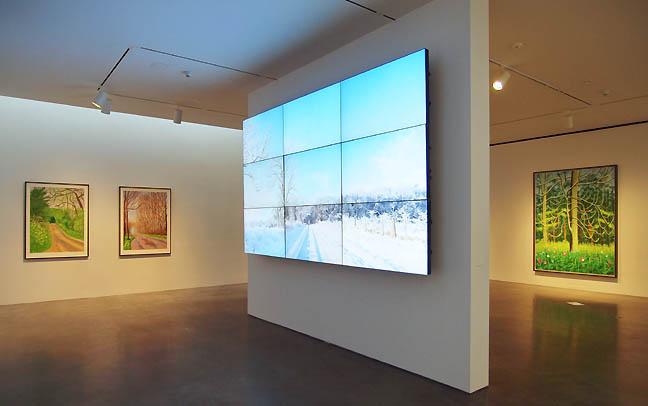 David Hockney's The Arrival of Spring, (far right) 4 May, 2011 [photos Jeff Jahn] For painters interested in alternative methods there are a few must see hyper sensual shows in New York like Chris Ofili's Night and Day at the New Museum and the heavy weight Matisse Cut Outs at MoMA. Both present painters with a tantalizing ability to reinvent themselves but perhaps the most exciting reinvention exhibition is David Hockney's The Arrival of Spring at Pace, which ends this Saturday. 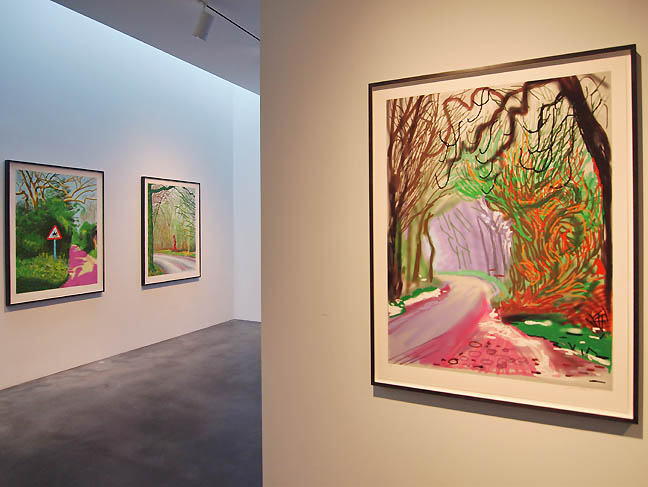 (at right) The Arrival of Spring in Woldgate, East Yorkshire in 2011 Consisting of prints made using an iPad, a 9 channel aggregate video and a series of drawing completed after Hockney suffered a mild stroke, all of the works depict a kind of homecoming as Woldgate is an ancient Roman road that Hockney first encountered at age 15. The repeated revisiting of a road is likely an oblique reference to Cezanne's roads and trees. I may also resemble the regular and revisited practice most painters with a tenth of Hockney's ability engage in as a practice. In a way painting as a discipline is an old road, which is why using an iPad is so loaded here. The prints he created using the iPad are indeed paintings, excellent ones... and in England in particular there was a lot of blow back when Hockney went off the reservation and traded a brush for a touchscreen. It is an old fashioned response and this second round of works at Pace (first displayed at the de Young Museum) are stronger than those he debuted in the British Isles. Partly, it is because of the way it brings his career full circle back to his pop works where at the time the brushwork was anything but traditional. Personally, I've always had reservations about Hockney because I loved those early works, mostly painted with a roller from the late 60's to 70's so much. For example, works like A Bigger Splash whose flat crisp expanses of color and sharp graphic content are rightly seen as highly influential upon modern animation. I can't imagine South Park, Anime, Aqua Teen Hunger Force or numerous other shows on Cartoon Network without his influence and it extends far beyond cartoons as the design industry also drew inspiration. Then came a long period of ultra colorful road and hill paintings. Many friends whose taste I respect just love those works but I find them lacking in the terse/tense nuance of the previous era. This is a reprise but it is far more personal in tone. 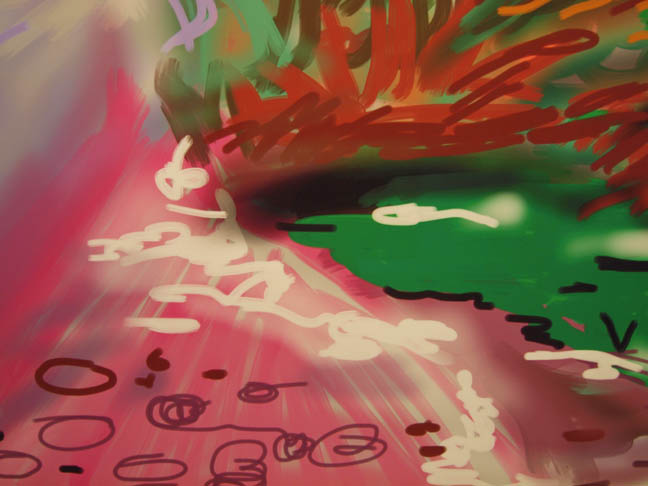
(detail) The Arrival of Spring in Woldgate, East Yorkshire in 2011 Works like The Arrival of Spring in Woldgate, East Yorkshire in 2011 have that same tour de force in graphic flatness, only now they seem to move as we get closer. Like the old pointillist trick from far away the work seems solid and whole but as we approach each squiggle and mark linger like sunspots on retina. For me it takes me out of time and place the way one loses time while playing video games. Two minutes or two hours it feels the same and this contemporary sense of time (or lack thereof) is remarkable. 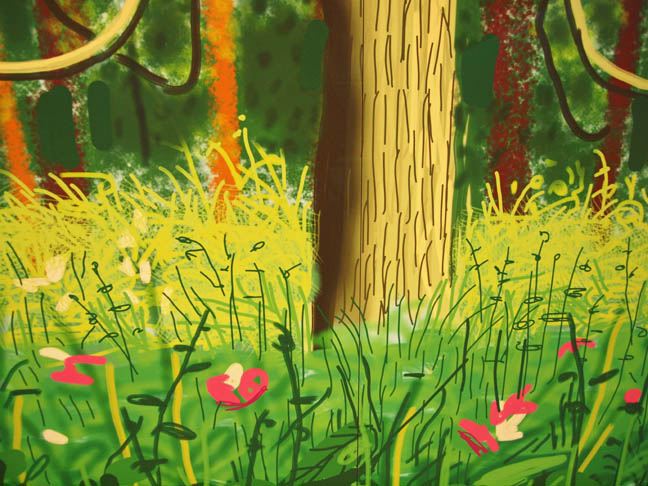 (detail) 4 May, 2011 The same goes for my favorite work in the show titled 4 May, 2011. It features a central tree that fills nearly the complete picture plane, not unlike Robert Adams' famous series of trees... where the limbs and trunk become both roads and ganglia for the eyes. With Hockney though we step closer and come face to face with internet graffiti. 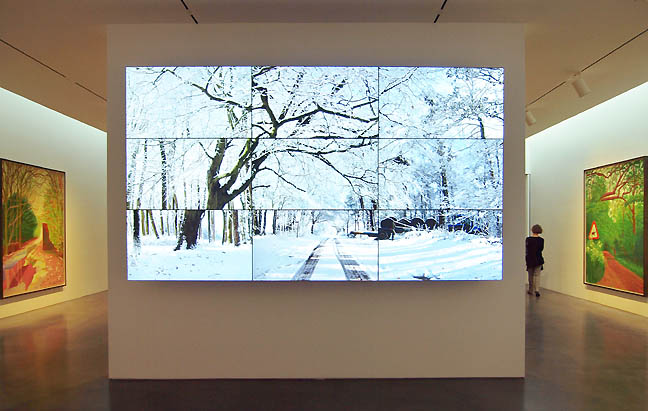
The viewer is ushered into the exhibition by the 9 channel video work titled Woldgate Woods, November 26th (2010). Fittingly it is the earliest work in the show and its slow insistent creep through the snow lets us great each scraggled tree like member of the community on a morning walk. The sometimes jerky transition of the scene in each scene which proceeds to the next one gives us somewhat of the air of expectation Hockney must feel for this place. The fact that most of it is a winter scene only further sets the stage. As someone who has grown up around a lot of trees lined roads and snow this is immediately familiar to me. 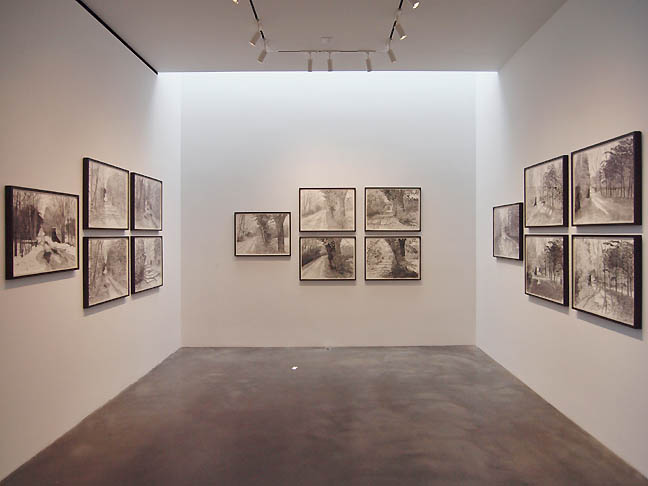
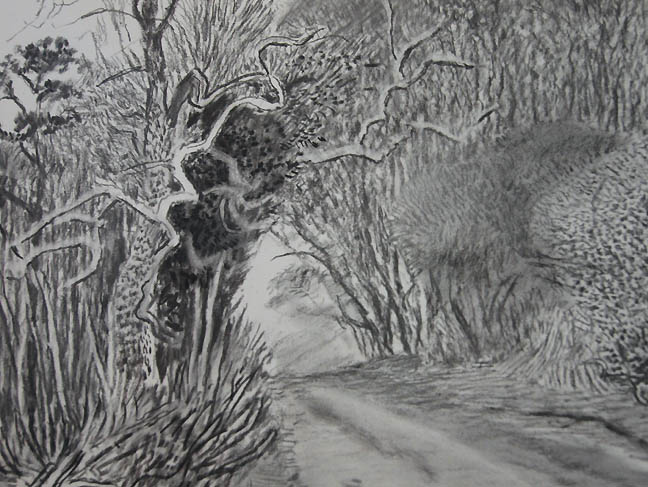 (detail) 6-7 May, 2013 The latest works are a series of drawings completed after Hockney suffered a mild stroke, leaving his speech impaired but not his drawing. His hand is so sure and remarkable as he attempts to capture some of the scene and his own pensive yet incredibly familiar catalog of his observations without using color. There is no wonder why he returned to this place after such a jarring incident and the minute shifts in shade angle and foliage density remind me of the familiarity a hunter, woodsman or farmer has for his own land. The fact that he can translate it for us into 2d is as astonishing as it is unpretentious. The entire exhibition feels like a muscle memory from the collective unconscious or the joy of seeing the wondrous minute changes in one's own neighborhood after being away for a while. Certainly having an old hand like Hockney bless the touchscreen isn't unlike Matisse undertaking cutouts (a younger artist will be seen as being gimmicky) and he could take this much farther yet. Every inch of this show is a sublime discovery. Show ends Saturday November 1, 2014 Posted by Jeff Jahn on October 31, 2014 at 7:04 | Comments (0) Comments Post a comment Thanks for signing in, . Now you can comment. (sign out)
(If you haven't left a comment here before, you may need to be approved by
the site owner before your comment will appear. Until then, it won't appear
on the entry. Thanks for waiting.)
|
| s p o n s o r s |
 |
 |
 |
 |
 |
 |
 |
 |
 |
 |
 |
 |
 |
 |
 |
 |

|
Site Design: Jennifer Armbrust | • | Site Development: Philippe Blanc & Katherine Bovee | |

